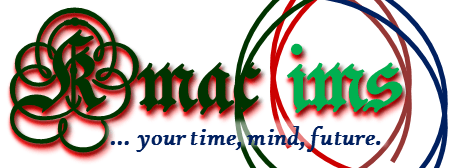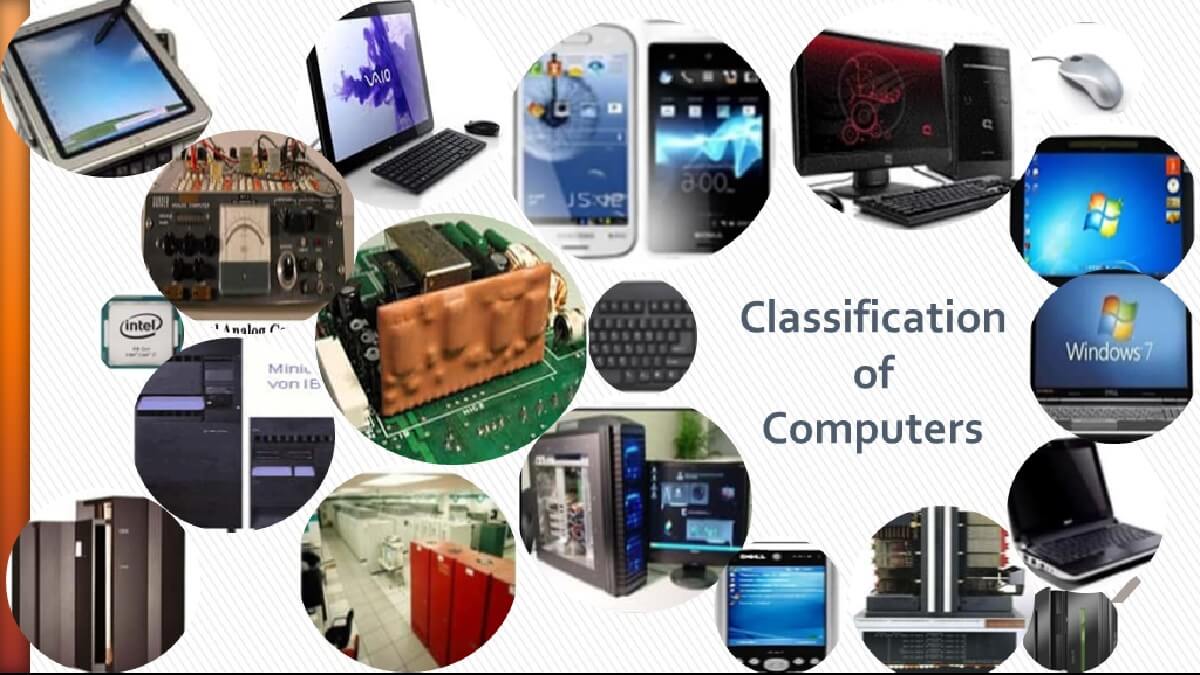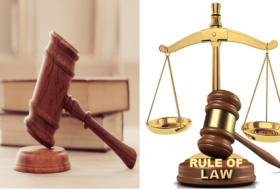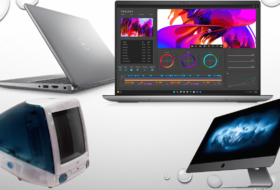There are different ways to classify a computer depending on your area of interest. because this article focuses on beginners and students, we shall discuss the four key classifications of computers. Elsewhere in the links below, we discussed each classification of computers in greater detail
In this article, we looked at the classification of computers under the following headings: classification of computers by:
In addition, we briefly explored the basic computer components such as:
- Hardware
- Software, and
- Peopleware
Table of Contents
The summary is illustrated in the infographic below.

Classification of Computers by Generation
Detail information on the generations of computers can be found in this article: Identifying Different Generations of Computers. Here, we summarized the classification of computers by generation as follows:
- First-generation computers were based on vacuum tubes. These machines were large in size, expensive to operate and instructions were written in machine language. Their computation time was in milliseconds.
- Second-generation computers were based on transistors. They were smaller, less expensive, and required less maintenance than the first-generation computers. They used the stored program concept. Programs were written in assembly language. The computation time was in microseconds.
- The use of Integrated Circuits characterized third-generation computers. They consumed less power and required low maintenance compared to their predecessors. High-level languages were used for programming. The computation time was in nanoseconds. These computers marked the beginning of commercial production.
- Fourth-generation computers used microprocessors designed using the LSI (Large Scale Integration) and VLSI (Very Large-Scale Integration) technology. The computers became small, portable, reliable, and cheap. The computation time is in picoseconds. They became available both to the home user and for commercial use.
- Fifth-generation computers are expected to be capable of learning and self-organization. The computers use SLSI (Super Large-Scale Integration) chips and have large memory requirements. They use parallel processing and are based on (AI) Artificial Intelligence. The fifth-generation computers are still being developed.
Classification of Computers by Types
There are three major classifications of computers by type, namely: Analog, Digital, and Hybrid computers. Let us discuss each in greater detail.
Analog Computers:
An analog computer is a kind of computer that represents data as a variable across a continuous range of values. The earliest computers were analog computers. Analog computers measure parameters that vary continuously in real-time, such as temperature, pressure, and voltage. Analog computers may be more flexible but generally less precise than digital computers. The slide rule is an example of an analog computer. In general, analog computers are extraordinarily fast, since they can solve most complex equations at the rate at which a signal traverses the circuit, which is generally an appreciable fraction of the speed of light. On the other hand, the precision of analog computers is not good; they are limited to three, or at most, four digits of precision.
Digital Computer:
A digital computer uses distinct values to represent the data internally. All information is represented using the digits 0s and 1s. The computers that we use in our homes and offices are digital computers. Digital computers can be built to take the solution of equations to almost unlimited precision, but quite slowly compared to analog computers. Generally, complex equations are approximated using iterative numerical methods which take huge numbers of iterations, depending on how good the initial “guess” at the final value is and how much precision is desired.
Hybrid Computer:
Hybrid computers are computers that exhibit features of analog computers and digital computers. The digital component normally serves as the controller and provides logical operations, while the analog component normally serves as a solver of differential equations. Hybrid computers can be used to obtain a very good but relatively imprecise ‘seed’ value, using an analog computer front-end, which is then fed into a digital computer iterative process to achieve the final desired degree of precision. With a three or four-digit, highly accurate numerical seed, the total digital computation time necessary to reach the desired precision is dramatically reduced, since many fewer iterations are required.

Classification of Computers by Size
A third classification of computers is by size. Computers are broadly classified into four based on their size, namely:
- Microcomputers,
- Mini-computers,
- Mainframe computers, and
- supercomputers.
Microcomputers:
Microcomputers are relatively small and low-cost. They consist of a CPU, an input unit, an output unit, a storage unit, and the software. Although microcomputers are stand-alone machines, they can be connected together to create a network of computers that can serve more than one user. Microcomputers include desktop computers, notebook computers or laptops, tablet computers, handheld computers, smartphones, and netbooks, as shown in the figure below.

The Desktop Computer usually called Personal Computer (PC) is the most common type of microcomputer. It is a standalone machine that can be placed on the desk. Notebook Computers or Laptops look like a notebook. They are portable and have all the features of a desktop computer. The advantage of the laptop is that it is small in size, can be carried anywhere, has a battery backup, and has all the functionality of the desktop. Laptops can be placed on the lap while working (hence the name). However, some laptops are costlier than desktop machines, depending on system configurations.
Netbooks are smaller notebooks optimized for low weight and low cost and are designed for accessing web-based applications. Starting with the earliest netbook in late 2007, they have gained significant popularity now. Netbooks deliver the performance needed to enjoy popular activities like streaming videos or music, emailing, Web surfing, or instant messaging. The word netbook was created as a blend of Internet and notebook. Tablet Computer has features of the notebook computer but it can accept input from a stylus or a pen instead of the keyboard or mouse. It is a portable computer optimized for web capabilities. A tablet computer is a new kind of PC.
Handheld Computer or Personal Digital Assistant (PDA) is a small computer that can be held on the top of the palm. It is small in size. Instead of a keyboard, PDA uses a pen or a stylus for input. PDAs do not have a disk drive. They have limited memory and are less powerful. PDAs can be connected to the Internet via a wireless connection. Over the last few years, PDAs have merged into mobile phones to create smartphones. Casio and Apple are some of the manufacturers of PDAs. Smartphones are cellular phones that function both as a phone and as a small PC. They may use a stylus or a pen or may have a small keyboard. They can be connected to the Internet wirelessly. They are used to access electronic mail, download music, play games, etc. Blackberry, Apple, HTC, Nokia, and LG are some of the manufacturers of smartphones.
Minicomputers:
Minicomputers are digital computers, generally used in multi-user systems. They have high processing speed and high storage capacity than microcomputers. Minicomputers can support up to 4 – 200 users simultaneously. The users can access the minicomputer through their PCs or terminal. They are used for real-time applications in industries, research centers, etc. PDP 8, IBM (8000 series) are some of the widely used minicomputers. The figures below are examples of minicomputers.
Mainframe Computers:
Mainframe computers are multi-user, multi-programming, and high-performance computers. They operate at a very high speed, have a very large storage capacity, and can handle the workload of many users. Mainframe computers are large and powerful systems generally used in centralized databases. The user accesses the mainframe computer via a terminal that may be a dumb terminal, an intelligent terminal, or a PC. A dumb terminal cannot store data or do the processing on its own. It has the input and output device only. An intelligent terminal has the input and output device, can do processing, but, cannot store data of its own. The dumb and the intelligent terminal use the processing power and the storage facility of the mainframe computer. Mainframe computers are used in organizations like banks or companies, where many people require frequent access to the same data. Some examples of mainframes are CDC 6600 and IBM ES000 series. The figures below are examples of mainframe computers.
Supercomputers:
Supercomputers are the fastest and most expensive machines. They have high processing speed compared to other computers. The speed of a supercomputer is generally measured in FLOPS (Floating Point Operations Per Second). Some of the faster supercomputers can perform trillions of calculations per second. Supercomputers are built by interconnecting thousands of processors that can work in parallel.
Supercomputers are used for highly calculation-intensive tasks, such as weather forecasting, climate research (global warming), molecular research, biological research, nuclear research, and aircraft design. They are also used in major universities, military agencies, and scientific research laboratories. Some examples of supercomputers are IBM Roadrunner, IBM Blue Gene, and Intel ASCI Red. PARAM is a series of supercomputers assembled in India by C-DAC (Center for Development of Advanced Computing), in Pune. PARAM Padma is the latest machine in this series. The peak computing power of PARAM Padma is 1 TeraFLOP (TFLOP). The diagrams below are examples of supercomputers.

Classification of Computers by Degree of Versatility
The fourth and final classification of computers is by degree of usage. Based on the degree of usage or versatility, computers fall into two groups:
- General-purpose computers, and
- Special-purpose computers
General-Purpose Computers:
General-purpose computers are designed to solve a large variety of problems. That is they can be given different programs to solve different types of problems. General-purpose computers can process business data as readily as they process complex mathematical formulas. General-purpose computers can store a large amount of data and the programs necessary to process them. Because general-purpose computers are so versatile, most businesses today use them. Most digital computers are general computers and it is mainly such computers that are used in business and commercial data processing. A PC or a Mac and other types of computers can do a huge amount of things. They can be used by different people for completely different kinds of jobs. They are general-purpose computers.
Special-Purpose Computers:
Special-purpose computers are designed to solve specific problems; the computer program for solving the problem is built right into the computer. Special-purpose computers have many features of general-purpose computers but are designed to handle specific problems and are not applied to other computerized activities. For example, special-purpose computers may be designed to process only numeric data or to completely control automated manufacturing processes. Moat analog computers are special-purpose computers. Special-purpose computers are designed to do specific kinds of jobs. A TV, a washing machine, an iPod, etc, are forms of computers, but they have only a small range of things that they can do and are designed specifically to do them.
Special-purpose computers are often used as training simulators. A simulator is a computer-controlled device for training people under simulated, or artificially created, conditions. The computer creates test conditions the trainee must respond to, it then records and evaluates the responses, providing these results to both the trainee and supervisor.
The Concept of Computer System
A computer can be defined as a programmable device that can automatically perform logical and arithmetic operations based on the input given by the user and returns the desired result after processing. A computer can also be defined as an electronic device that accepts data, processes it, stores the data as per user instruction, and gives the results quickly and accurately. A computer system is a combination of hardware and software that takes input, processes them, and gives output. Computer components are divided into two major categories namely hardware and software. Hardware is the machine itself and its connected devices such as monitor, keyboard, mouse, scanner, printer, etc. Software is the set of programs that make use of hardware for performing various functions.
A computer has the following characteristics:
- It processes complex computations faster and more accurately than human beings
- It can store a large amount of data while working for hours without breaking or inputting errors
- A computer can perform different kinds of work at the same time
- A computer cannot work except instruction is passed to it
- A computer does not have emotions, knowledge, experience, or feeling, hence a computer cannot think.
Components of Computer System
There are three major components of a computer system, namely: hardware, software, and peopleware.
Hardware components
These include the physical components that make up a computer system. The hardware components include all components that a user can see and touch while using the computer. A computer system consists of four basic units; namely the input unit, a storage unit, a central processing unit, and an output unit. The central processing unit is further divided into Arithmetic logic unit and a control unit. These four units enable the computer to perform the following five basic functions:
- Accepts data or instructions as input
- Stores data and instructions
- Processes data based on per-user instructions
- Controls all operations inside a computer
- Gives results in the form of output to the user.
Input devices: Input devices are used to enter data into the computer system. The hardware components that make up the input unit include a mouse, keyboard, scanner, touchscreen monitor, camera/camcorder, joystick, and microphone.
Storage devices: Storage devices are used by the computer system to save data and information for future use. Some of the hardware components that make up the storage devices include:
Primary memory/storage: Random Access Memory (RAM), Read-Only Memory (ROM), cache, and flash memory.
Secondary (internal) storage: Hard Disk Drive (HDD) and Solid State Drive (SSD)
External storage: CD/DVD, diskette, flash drive, external hard disk, blue-ray disk, and a pen drive.
The central processing unit (CPU): This is the processing center of the computer. It is the center where all arithmetic and logical operations of the computer are performed. The CPU takes data and instructions from the primary memory and performs calculations based on the instructions given and the type of data provided. The CPU is divided into the Arithmetic logic unit (ALU) and control unit (CU).
The Arithmetic Logic Unit performs all calculations and comparisons based on the data and instructions provided. It performs arithmetic functions such as addition, subtraction, multiplication, and division and logical operations such as greater than, less than, greater than or equal to, equal to, etc.
The Control Unit controls all operations of the computer. It takes care of the step-by-step processing of all operations inside the computer. Operations such as input, processing, and output are performed by the control unit.
Output devices: Output devices are used by the computer system to give, show or display results to the user. The hardware components of the output unit are Monitor, printer, and speaker.
Identifying hardware components



Software components
Software components of a computer system have no physical presence but are a set of instructions and data stored in digital form within the computer memory. They have basically divided into two: system software and application software.
The system software is used to manage and control the hardware components of the computer. It allows for user interaction between the hardware and application software. There are two major categories of system software: the operating system and device drivers.
An application software otherwise called ‘apps’ are designed to allow users of a computer system to complete specific tasks. The application software is the major purpose for which we buy and learn how to use the computer system.
Application software can either be generic or bespoke. Generic application software is usually mass-produced with the intention that it will be used by a wide variety of different users in a wide range of different situations. This makes their cost cheaper and availability rampart. The bespoke or custom-built software is created for a specific purpose that will be used in a known environment. This makes them more expensive and very rare to see.
Another type of software is utility software. It helps a user to maintain and protect the computer system but does not directly interface with the computer hardware. Examples are anti-virus software, firewalls, disk defragmenters, disk cleanup, etc.
People-ware components
The computer is designed to be used by people. The people who use the computer are referred to as the peopleware component of the computer system. Peopleware refers to the role of people in the development and use of computer software and hardware.
Anyone who designs, develops, or uses computer systems plays an important role in the computing process. They include computer professionals and users such as computer engineers, programmers, individual computer users, software engineers, IT specialists, network engineers, graphic designers, computer technicians, database administrators, desktop publishers, etc.
The relationship between hardware, software, and people-ware
- The hardware, software, and peopleware are indispensable. All of them complement one another and none can function without the other. For example, people created both the software and the hardware, and the hardware cannot function without the software, and neither will the software function without the hardware. Also, both the hardware and software need people to operate them for them to function.
- One hardware can be used to load different software depending on who is using it. This means that people (users) determine the kind of software that can be loaded (installed) in computer hardware.
- The kind of job people does determines the kind of hardware and software that they can use. For example, the kind of computer hardware and software a film editor uses is different from the kind desktop publisher uses.
- Hardware is mostly purchased once while software used in computer hardware changes over time. Similarly, one or more persons can use computer hardware and software over time.
- Hardware, software, and peopleware can be upgraded over time. This means that obsolete and less functional hardware can be changed or upgraded for more efficiency, while over time, the software is updated to accommodate recent development in information and communication trends. Also, computer professionals and users upgrade their knowledge of innovative developments in the hardware and software industry to maximize productivity and usability.
Definition of Software
Computer software can be visualized as the intangible component of the computer system. It is the collection of programs, instructions, and data that directs the computer to perform specific tasks.
System Software
The system software is the backbone of the computer system. It has various functions including, controlling, integrating, and managing the computer hardware components. It also interfaces between the user, application software, and hardware such that users of the system see it as a functional unit. System software can be classified as the operating system, drivers, and utilities.
Operating system:
Examples of the operating system include Unix, Linux, Mac Os, OS/2, Xenix, Windows NT, Windows XP, Windows 7, Windows 8.1, HP-UX, Android (for mobile devices), etc.
Drivers:
Device drivers are operating system specific. A driver that works in Windows 7 may not necessarily work in Windows 8. Examples of device drivers: printer drivers, video adapter drivers, network drivers, sound card drivers, etc.
Utility software:
Utility software is routine software that is packaged with the operating system which helps in system maintenance. Examples of utility software include Norton Antivirus, McAfee Antivirus, Scandisk, disk defragmenter, backup and recovery manager, etc.
Application Software
Application software is used to accomplish specific tasks other than just running the computer system. There are different kinds of application software such as word processing software, spreadsheet application software, graphics, multimedia software, database software, etc. Application software may consist of a single program e.g. AVS Video editor, a small collection of programs that work closely together to accomplish a task e.g. Microsoft Office Word, or a larger collection of related but independent programs and packages that have a common user interface or shared data format, such as Microsoft Office suite, Macromedia MX, CorelDraw graphic suite, etc.
Examples of application software:
Word Processing – MS Word, WordPad, WordPerfect, word star, text maker, Lotus word pro, Microsoft Works, etc
Spreadsheet applications – MS Excel, Lotus 1-2-3, Quattro Pro, PlanMaker, OpenOffice.org Calc, AppleWorks, Accel, etc.
Graphics Design applications – 3D Studio Max, CorelDraw, Macromedia Dreamweaver & Fireworks, paint, photoshop, illustrator, InDesign, GIMP, Serif DrawPlus, etc.
Multimedia software – Windows media player, Real player, Total video player, Gamut, Winamp, etc.
Database applications – MS Access, Oracle, MySQL, MS SQL Server, DB2, etc.
Definition of an Operating System (OS)
An Operating System (OS) can be defined as system software that manages computer hardware and software resources. It is a vital component of the computer system and it provides common services for computer programs. Application software is usually dependent on the operating system to function.
Examples of Operating Systems
Different operating systems are used in computer systems today. The most popular ones which are mostly packaged together with a new system sold in the market include:
- FreeDOS– an improved version of DOS (Disk Operating System)
- Unix– a stable multi-user & multitasking OS for server systems.
- Linux – usually available as commercial and Open Source software. There are different Linux OS depending on the distribution: Red Hat, Ubuntu, OpenSuse, Fedora, LinuxMint, Debian, etc.
- Macintosh – usually called Mac, was introduced by Apple Computer.
- Windows – which is the most popular OS used today, especially in Nigeria. Windows OS is developed by Microsoft Inc. It has various versions including Windows 95, 98, Me, NT, XP, Vista, 7, 8, 8.1, etc.
Functions of the Operating System
The basic functions of an operating system are:
- It helps in booting the computer system
- It monitors the system performance and activities
- It helps in managing various peripheral devices such as mouse, keyboard, printer, etc
- It provides a user interface for the effective operating of the computer, e.g. command line and graphical user interface (GUI)
- It helps in resource allocation such as the computer’s memory and sharing of the central processing unit time by various applications or peripheral devices
- It provides a system of file management which includes the way the operating system manipulates, stores, retrieves, and saves data.
- It assists in computer utility functions such as backup and restore operations, defragmentation, disk cleaning, etc.




